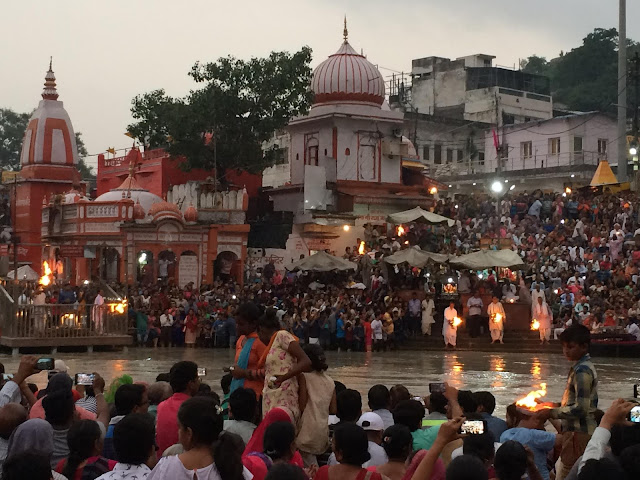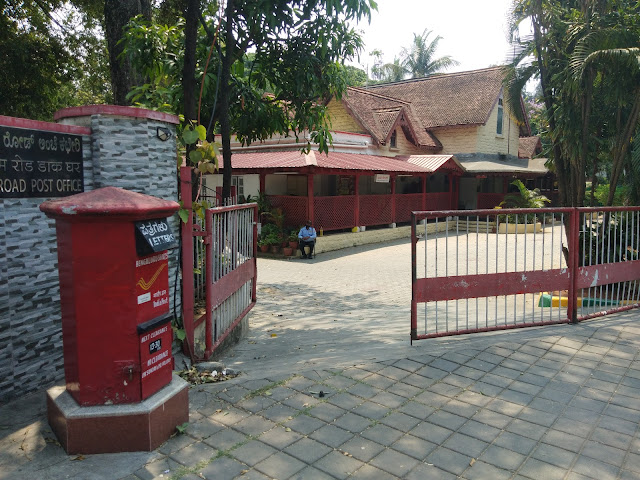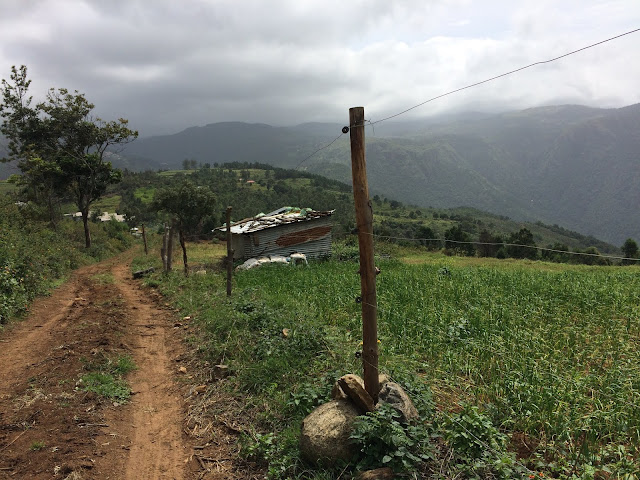Valley Of Flowers – The Himalayan Treasure
Valley Of Flowers – The Himalayan
Treasure
12th August – 20th
August 2017
Nestled in the beautiful Himalayas is a beautiful valley
called Valley Of Flowers.
Once hidden from the outside
world, the valley was believed to be a playground of the Gods and fairies. The
valley was accidentally discovered by Frank Smith a mountaineer and botanist.
He was so mesmerized by the beauty of the valley that he went on to write a
book about it! The valley indeed looks beautiful with over 300 different
varieties of flowers spread over miles in the valley. I had a pleasure to visit
this valley this august.
Let me take you on
this memorable trek and give you a glimpse valley through my eyes.
We were a group of 16
ladies from different parts of India who met at Dehradun Airport for this tour
package which covered Haridwar, Rudraprayag, Govindghat, Ghangria (our base
camp and we go to valley of flowers and Hemkund Saheb from here) and back to
Dehradun in the same way covering all the places in reverse order J
Day 1: Dehradun – Haridwar (53 Km) Drive time 2-3 hours
We arrived in
Dehradun from our respective cities. Dehradun Airport also known as Jolly Grant
Airport is the smallest airport I have ever seen till dateJ.
We began our journey
towards Haridwar after having Lunch at Padmini Palace. Later in the Evening
around 05:45 Pm we drove to Har ki Pauri for the famous Ganga Aarti. Aarti in
Haridwar is a spectacle with hundreds of pilgrims chanting and praying
together. It was really nice to be a part of this mesmerizing experience with a
huge crowd offering prayers in the setting sun. Located at the point where the
Ganges emerges from the Himalaya, Haridwar (also called Hardwar) is
Uttarakhand’s holiest city, and pilgrims arrive here in droves to bathe in the
fast-flowing Ganges.
Day 2: Haridwar
– Rudraprayag (165 Km) Drive time: 6-7 hours
After an early
breakfast, we started our journey to Rudraprayag. Haridwar to Rudraprayag is a
scenic drive along the Ganges up to Devprayag and along Alaknanda up to
Rudraprayag.
Named after Lord
Shiva, Rudraprayag is one of the Panch Prayag of Alaknanda River.
We got lucky to see
all the panch prayag’s during our trip –
·
Devprayag
-> where river Alaknanda meet river Bhagirathi
·
Rudraprayag
-> where river Alaknanda meet river Mandakini
·
Karnaprayag
-> where river Alaknanda meet river Pinder
·
Nandprayag:
-> where river Alaknanda meet river Nandakini
·
Vishnuprayag
-> where river Alaknanda meet river Dhauli Ganga
We reached Rudraprayag
late in the evening. Our stay for the night was arranded at Monal Resort which
was situated in a beautiful location and offers wonderful views. This hotel is
named after Monal Bird which is the state bird of Uttarakhand.
Day 3: Rudraprayag
– Govindghat (135 Km) Drive time: 5-6 hours
We did an early start
today to Govindghat from Rudraprayag.
We had a surprise
element enroute by our tourist guide which is Badrinath temple. The roads were
blocked due to landslide until few days before we arrived. We were lucky that
these blockers were cleared and we could visit the temple.
We reached Badrinath Temple by noon. This
is one of the most visited pilgrimage centers of India and one of the four char
dham’s. The image of the presiding deity worshipped in the temple is a 1 m
(3.3 ft) tall, black stone statue of Vishnu in the form of Badrinarayan.
We got to see the Tapt Kund which is a hot water pond. Water in this pond is
hot throughout the year and many pilgrims consider it a
requirement to bathe in the springs before visiting the temple.
After visit at
Badrinath temple, we went to Mana
Pass.
Mana Pass is a
mountain pass in the Himalayas on the border between India and Tibet. It
appears to now be one of the highest vehicle-accessible pass in
the world, containing a road
constructed in the 2005-2010 period for the Indian military by the Border Roads Organization. We started our trek to the road from
Mana Village which is the last India village situated at Indo-China border. It
was a steep climb uphill to reach the Indio-Tibet road. Enroute climbing this
hill, we saw Vyas Gufa. Vyas
Cave is an ancient cave located on the banks of Saraswati River at Mana village
in the Chamoli district of Uttarakhand. Vyas Gufa is believed to be the place
where sage Vyas composed the Mahabharata epic with the help of Lord Ganesha. A
distinct feature of the temple is the roof which resembles the pages from the collection
of his holy scripts.
Ganesha cave is also
located in nearby area below the Vyas cave. Near this temple, is a natural rock
that rests over the river known as Bhim pul
There is also an
interesting story related to the place that explains the broken tusk of Lord
Ganesh. When Vyas was composing Mahabharata, he needed someone to take down his
dictation and asked the learned Ganesha for the same. Ganesh agreed but he had
a condition - that Vyas would not stop even for a moment or else he would stop writing
and leave. Vyas dictating as fast as he could and Ganesh bent down over the
script pages. Finally, his reed pen broke. To which, he broke off a part of his
tusk to be used as a pen thereon.
Finally we could make
it on top and landed right on the Indo- china road. We started walking on the
road and at one point noticed river Saraswati flowing ferociously. Mana Pass is
the source of the Saraswati River, the longest stem of one of the longest Ganges tributaries,
the Alaknanda River. Mythical Saraswati River flows
in to the big orifice in the ground before it disappears.
Enroute we crossed Joshimath
- the winter home of Lord Badrinarayan, when the temple at Badrinath closes. It
is considered to be one of the most sacred places by Hindus who believe that
Badrinath (The God Vishnu) resides here in winter.
Finally we reached Govindghat
late evening which is located in the Chamoli district of Uttarakhand and is
beautifully situated at the convergence of the Rivers Alaknanda and Lakshman
Ganga. Overnight stay is at Bhagat Hotel.
Day 4: Govindghat
– Ghangaria (Trek - 9kms/ 6hrs approx.)
We started early
morning on our trek to Ghangaria(9 kms) from Govindghat. Ghangaria is also the
base camp for the treks to Valley of Flowers. It is situated at the confluence
of the rivers Bhyundar Ganga and Pushpawati, which forms Lakshman Ganga. It is
the last human habitation in the Bhyundar valley. This place is usually used by
travelers as a base camp to visit Hemkund Sahib and Valley of flowers. It is
only open from May till September. The rest of the year, the valley is covered
under snow.
The good bit on this
trek is that there are markers. That means you know you have walked 2 kilometers
and you need to walk 7 more. The path winds around the River Lakshman Ganga for
most of the way. It is a good trek as it does not go uphill all the way. There
are short sections that are flat and some even downhill. Most of the way is
uphill but gradually uphill. Lot of Poni’s(Mules) carrying people and our
baggages ply on the way who act as our speed breakers. Also there are some tea
shops after some kilometers for you to take refreshments, regain energy and
start again. You get to meet a mixed crowd enroute this trek where a lot of
people are pilgrims to Hemkunt Sahib rather than trekkers and it makes for an
interesting mix. Finally we made it to our Ghangaria tents in the evening at 5
PM.
We stayed overnight
at our camps in Ghangaria village.
Day 5: Ghangaria
– Valley Of Flowers (Trek 3 + 3km’s to the entry point)
Ghangaria to the
Valley Of Flowers entry point is gradual uphill which is 3 km and scenic trek
that greets you with cool breeze and breathtaking views. The entry gate to the
park is close from Ghangaria however we need to walk 3km moderately uphill to
reach the Valley.
After the entry
point, you are free to move around at your own pace to enjoy the scenic views
of the valley.The Valley Of Flowers is a UNESCO world heritage site. The flora
includes orchids, poppies, primulas, calendulas, daisies and anemones, and also
rare species like the Brahmakamal, the Blue Poppy and the Cobra Lily.
A stone path meanders
among the flowers and across streams. This stony terrain into the valley is
little tough to climb so watch out your feet and thanks to our guide who asked
us to carry two trekking poles for support. The flowers are so beautiful that leaving
the path is difficult. Few visitors return after reaching the center of valley
but we continued beyond the first one or two kilometres inside the Valley. I
was quite excited to see these rare flowers and went on clicking pictures of
flowers and also drank from a mountain spring.
Day 6: Ghangaria – Hemkund
Sahib (Trek – 6+6kms/ 4 hrs each way approx.)
We started on our
trek early in the morning to Hemkund Sahib. This is a moderate trek, 6 km each
way and usually takes about 4 hours each way. The climb to Hemkund Sahib is
pretty steep as it is the world’s highest Gurudwara and is located near a
beautiful glacial lake surrounded by mountains. It is a pilgrimage place for
both Hindus and Sikhs. The name Hemkund Sahib denotes the presence of a tank of
snow. On a clear day one can catch a beautiful reflection of the Gurudwara in
the lake.
The trail is wide and
very well maintained. We saw lot of crowd on this path some known faces whom we
met on VOF and rest were pilgrims. And ofcourse our closest companions – Poni’s
J.
Initial early morning
trek was good but after around 4 hours it started taking a toll on me. I had
two friends who were slow walkers like me and we maintained the same pace on
first two days. Hence we 3 were walking partners. It so happened that when we
stopped at 11 for tea, people from our tent who had started 2 hours later than
us crossed usJ. So we knew we had to gear up now.
Then somewhere far from Gurudwara we heard the bhajans and that really
motivated us to walk ahead. Finally after 7 hours we made it to Gurudwara on
top. Our guide first asked us to go near the lake, wash our legs and took a pic
of the Gurudwara. The lake also has a small temple devoted to Lord Lakshman. People
say this is the only Lakshman temple in India.
Whatever time I was
there, the lake was surrounded by mist and a little later it almost completely
vanished from the view. We visited both the temple and the gurudwara. A little
later we ate khichdi and had tea from the langar.
Then it was time to head back.
Now it was time to
climb down the same distance again but in a slower place though J. We spotted the famous flower Brahmakamal. Brahma Kamal is
another exotic flower that is not found in the VOF but enroute Hemkund Sahib.
Walking down our
guide took us through a short cut which was all steps climbing down. We took
lot of breaks climbing down since major milestones of the trip were achiever.
Now all we were looking forward was going back to Govindghat from Ghangria camp
the next day.
We trek back to the
Ghangaria camps for the night.
Day 7: Ghangaria - Govindghat (Trek -
9km’s/6hrs) – Rudraprayag (135 Km) Drive time: 5-6 hours
We started our return
journey today with a trek down to Govindghat early in the morning at 7 since
later in the day sun would be too strong.
While some of us
decided to trek back, some decided to go on Poni’s and other preferred to take
helicopter to enjoy the scenic view from top. I decided to take Poni for a
change but descending downhill on a Poni was a completely different experience
altogether. This time we got to enjoy the scenic view better since there was
not target to be reached.
On arriving at
Govindghat, we went to Yogadhyan Badri Temple which is located at Pandukeshwar
near Govind Ghat. When the temple of Badrinath is closed during the winter,
Yogdhyan Badri serves as the abode for the Utsav-murti or festival-image of
Lord Badrinath. Hence, it is religiously ordinated that a pilgrimage will not
be complete without offering prayers at Yogadhyan Badri.
We came back to
Govindghat hotel and started our journey to Rudraprayag. Stayed overnight at
the same Monal Resort.
Day 8: Rudraprayag
–Rishikesh - Haridwar (163 Km) Drive time: 5 - 6 hours
We started our
journey to from Rudraprayag to Rishikesh.
Rishikesh also known
as “Gateway to the Garhwal Himalayas” and “Yoga Capital of the World”. There
are lot of yoga centers that attract tourist.
It is also a popular
spot for adventure sports. We saw lot of signboards of bungee jumping, hiking, kayaking, mountain biking, rock climbing, rappelling,
and zip lining. Rishikesh
is becoming a popular spot for white water rafting enthusiasts, both from India
and abroad, as the Ganges offers
medium to rough rapids
We had lunch in an
Italian Restautrnat since we were bored eating dal, roti and aloo gobi all the
days. After lunch we started to head towards Lakshman Jhoola. This is an iron
suspension bridge across the river ganges. The bridge connects the two
villages; Tapovan in Tehri Garhwal district to Jonk in Pauri Garhwal district crossing the river
from west to east. We crossed the bridge amidst animals, motorists and human
beings and reached the other side. Quickly checked out some shops but did not
find any stuffs worth taking home. Came back to our coaches and started our
journey back to Haridwar.
Day 9: Haridwar–
Dedradun (53 Km) Drive time: 2 - 3 hours
Last day of our trip,
after breakfast started to Dehradun airport to catch our return flights to
respective cities carrying a baggage full of wonderful memories J













Comments
Post a Comment